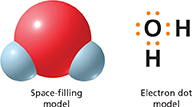Measuring
Measurements are important in science because they provide specific information and help observers avoid bias. Measuring is comparing an object or process to a standard. Scientists use a common set of standards, called the International System of Units, abbreviated as SI (for its French name, Système International d'Unités).
What distance does the ball travel in each time interval in the strobe photograph? You can make measurements on the photograph to make more precise statements about the ball's motion.
Calculating
Once scientists have made measurements, calculations are a very important part of analyzing data. How fast is a ball moving? You could directly measure the speed of a ball using probeware such as a motion sensor. But you can also calculate the speed using distance and time measurements. Calculating is a process in which a person uses mathematical operations to manipulate numbers and symbols.
Classifying
Classifying is grouping items according to some organizing idea or system. Classifying occurs in every branch of science but it's especially important in chemistry because there are so many different ways that elements can combine to form compounds.
Sometimes you place objects into groups using an established system. Other times you create a system by observing a variety of objects and identifying their properties. For example, you could group household cleaners into those that are abrasive and those that are not. Or you could categorize cleaners as toxic or non-toxic. Ammonia is toxic, whereas vinegar is not.

Using Tables and Graphs
Scientists represent and organize data in tables and graphs as part of experiments and other activities. Organizing data in tables and graphs makes it easier to see patterns in data. Scientists analyze and interpret data tables and graphs to determine the relationship of one variable to another and to make predictions based on the data.

Using Models
Some cities refuse to approve new tall buildings if they would cast shadows on existing parks. As architects plan buildings in such locations, they use models to show where a proposed building's shadow will fall at any time of day at any season of the year. A model is a mental or physical representation of an object, process, or event. In science, models are usually made to help people understand natural objects and the processes that affect these objects.
Models can be varied. Mental models, such as mathematical equations, can represent some kinds of ideas or processes. For example, the equation for the surface area of a sphere can model the surface of Earth, enabling scientists to determine its size. Models can be two-dimensional (flat) or three-dimensional (having depth). In chemistry, for example, there are several ways to model the arrangement of atoms in a molecule. Two models for a water molecule are shown above. The electron dot model is two-dimensional. It has the advantage of clearly showing how electrons are shared among atoms in the molecule. The space-filling model cannot show the number of electrons inside the atoms or between atoms, but it does show the arrangement of atoms in space.




